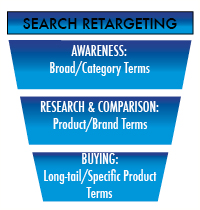5 Reasons Why Brand Marketers Should Use Search Retargeting
Are you looking to create brand awareness online? Wouldn’t it be great if you could target consumers who recently searched on your targeted terms? Well that’s exactly what search retargeting can help you do. It offers brand marketers a very precise method to reach their audiences. Let’s take a look at why. Search Retargeting In […]
Are you looking to create brand awareness online? Wouldn’t it be great if you could target consumers who recently searched on your targeted terms?
Well that’s exactly what search retargeting can help you do. It offers brand marketers a very precise method to reach their audiences. Let’s take a look at why.
Search Retargeting In A Nutshell
Search retargeting combines the precision and efficiency of search marketing with the reach and branding power of display.
Search retargeting allows you to marry your existing keyword lists with relevant banner ads to target consumers who have demonstrated interest in a particular offering, and search retargeting enables you to continue the conversation with prospective customers beyond the search engines.
In other words, it gives you another shot to create awareness with those customers who initially searched on your targeted terms. As a result, it increases the chances that they will visit your site, and in turn, it boosts the efficacy of your banners.
Understanding The Value For Brand Marketers 
Search retargeting is an effective strategy for brand marketers for the many of the same reasons that it is effective for search marketers.
For example, it enables them to target users at the top of the purchase funnel, it allows them to instantly build custom audience segments based on user-intent.
Retargeting also allows brand marketers to continuously fine-tune their segments during a campaign; and it offers them insights into which types of users respond to what creative sets.
Seeing It In Action
Twenty-eight million impressions in 60 days — that’s what one major online advertiser achieved with a recent search retargeting campaign.
Designed to drive brand awareness and increase qualified traffic to their website, the campaign exposed their banner to millions of users who had recently searched on targeted search terms.
In addition, it drove more than 55,000 visits to their website at an average cost of less than $0.80 per visit.
Five Reasons To Use Search Retargeting
Search retargeting is particularly well suited for brand marketers. Below are a few reasons why:
1. Reach intenders
Most online marketers agree that search is the gold standard for online advertising. How better to spend brand advertising dollars than by displaying banners to users who have actively searched on terms relating to the advertiser’s products?
Search retargeting provides just this opportunity, allowing advertisers to combine the brand impact of static or flash banners with the targeting capability and precision of search.
2. Create custom segments for each campaign:
There is no reason for brand advertisers to accept “one size fits all” behavioral segments, as different campaigns have different creatives and different goals. Brand marketers can improve performance with custom behavioral segments for each campaign.
In search retargeting, behavioral segments are defined by the search terms on which users have searched. Additionally, advertisers can see exactly how each keyword is performing in their campaign, whether on a CTR, CPC, or CPA metric.
The targeting that works for one set of client creatives may be very different from the targeting that works for another set of creatives for the exact same product. Different calls to action and graphic elements impact response rates of different types of targeted users.
3. Eliminate the wait to build cookie pools
In many cases, custom behavioral segments require weeks for a cookie pool to be built up in order for a campaign to be delivering at full strength.
With keyword-level search retargeting, this wait is eliminated as data is stored in memory for instant access. This “instant-on” feature provides flexibility in creating and launching multiple campaigns that test and improve performance.
4. Tune segments during campaigns
Because the keyword lists that drive search retargeting can be instantaneously adjusted at any time during a campaign, audience segments in search retargeting are typically tuned for optimum performance during campaigns.
As the initial campaign data shows which keywords are performing well and which are not, segments can be tuned by eliminating poorly performing keywords and adding keywords similar to those performing well.
In addition, bids on individual keywords can be raised or lowered to achieve the desired KPIs.
5. Gain valuable insights into your target audience
With keyword level search retargeting, advertisers see exactly how users respond, broken down by the keyword on which they searched. So, advertisers can see the spend, number of impressions, clicks, conversions, CPM, CTR, CPC, and CPA for each keyword in the campaign, and even for each creative in the campaign.
Using this insight, advertisers can design more effective campaigns going forward based on the most effective keywords.
Overall, search retargeting offers brand marketers an opportunity to capitalize on their existing keyword lists and apply them to display. Doing so will enable them to create awareness with their audiences in a very precise, highly effective, and efficient way.
Contributing authors are invited to create content for Search Engine Land and are chosen for their expertise and contribution to the search community. Our contributors work under the oversight of the editorial staff and contributions are checked for quality and relevance to our readers. The opinions they express are their own.
Related stories
New on Search Engine Land
